CHAPTER 14
How to develope pictures with coffee.
the author discovered in costa rica in the year 1989, coffee as reducing agent for silver salts. He worked out a COMPLETELY NON TOXIC DEVELOPER and also engineered a silver chloride emulsion which can be developed with coffee.

Coffee As Photographic Developing Agent for Silver Salts Coffee as a developer for silver based photographic materials (paper and films) was discovered by the artist in Costa Rica. The year was 1989. Caffeic Acid, is one of the most important reducing agents in coffee but by no means the only one.
How Coffee as Developer
For silver salts was discovered:
Coffee as reducing agent was discovered when the artist was improving Thomas Manley's old "OZOTYPE" process. To elucidate the research environment It is necessary to give a synopsis of pigment printing with chromates. in 1839 Mungo Punton dipped paper in a 10% solution of potassium bichromate, dried it, exposed it under light in contact with a design and observed that it was colored brown by the rays of light. the image was "fixed" just by rinsing in water because chrome salts exposed to light becomes insoluble in water. the final result was a brown chrome oxide image on paper.
In 1873 A. Marion, showed that when this chrome oxide "primary" image produced by Punton's process on paper (exposed under a negative) was pressed (in humid state) into close contact with a paper previously coated with mixture of gelatin and pigment, (Example: gelatine 10 gms, pigment: 2.5 gms, water 100 ml) the insoluble light primary positive image would transfer from the exposed paper to the unexposed gelatin pigment paper (in about 10 hours).
After 10 hours contact, both papers "primary" image and gelatin pigment paper still sticking together were then soaked in hot water until the backing paper that served as support for the pigment gelatin mixture, would float off (and discarded) leaving a photographic gelatin pigment image firmly attached to the primary chrome oxide image. just like in the carbon process- mentioned below- previously worked out by Poitevin, Swan and others.
 Thomas Manly, (1898) improved the Mariotypes (Marion's process) He mixed potassium bicromate with manganese sulphate brushed on paper Example:
Thomas Manly, (1898) improved the Mariotypes (Marion's process) He mixed potassium bicromate with manganese sulphate brushed on paper Example:
potassium bichromate 10g / manganese sulphate 20g, water 100 ml. To get a stronger colored and more powerfully reactive primary image,
before contacting this with the gelatin pigment paper, He dipped the latter in an acid solution where he included hydroquinone (a photographic developer)
to accelerate the chemical reaction. (about hydroquinone: 1 gm/ in water: 1 liter)
Instead of waiting for an 10 hour contact as Marion had done for the catalytic action to take place between the primary image and pigment paper,
he only had to wait about 2-4 hours until both papers, sticking together, dried.
As given by Manley, a typical acid reducing composition for the purpose is:
water........................1000 ml
Hydroquinone .. ....1.25 grams
glacial acetic acid .....4 ml
glycerin................. ...8 ml
for more contrast the acid in composition above can be increased, for less contrast: the amount of hydroquinone is increased. Summarized, Manleys directions were the following:
After about 2 minutes soaking of the pigment paper in acid reducer above, it was pressed in contact with primary image and left to dry attached there on.
this took from 2 - 4 hours. depending on paper thickness and climate conditions. The glycerin above was included to cause the gelatin to release the backing paper more easy in the next step, which was soaking the combination primary / pigment paper in cold water for 30 minutes, then in hot water at 45c for "development". development, as mentioned earlier, is dissolving out the soluble gelatin to obtain a final pigment image on top of the primary chrome image.
A disadvantage of Manly's Ozotype process is that if acidity is not regulated meticulously it tends to yield hard contrasty images with details washing off. Manley very well knew this, that is why in order to make the image details more resistant to washing off during the "developing " in hot water step, He let the gelatin pigment paper dry first (adhered on top of the primary image) This prolonged the process, made it to slow for production on a large scale.
Manley called his process "OZOTYPE" because He believed that ozone played the principal role in the chemical reactions.

In the year 1989 in Costa Rica
With the intention of improving Manley's Ozotype process, working in his research laboratory, the artist made some changes, among other things a faster more versatile process was wanted. first,
the acetic acid in Manley's composition above, was substituted for a 40% instant coffee solution which is quiet acid, a pigment image was obtained. In The next step, to study the effects of the ozotype process in the absence of reducing agent, the hydroquinone was deliberately left out the composition, the new testing ozotype composition devised by the artist writing these lines was:
2 % instant coffee solution..........................200 ml
1% chromic acid solution......................... 2 ml
glacial acetic acid...................................... 0.5 ml
the pigment paper was immersed for two minutes in solution above and immediately after, pressed in contact with the chrome primary image for only 15 minutes, separated, and transferred face down by pressing unto a glass plate, left 10 minutes in contact with the glass before immersing (Both pigment paper and glass) in 35c warm water to make the backing paper float off and dissolve out the soluble pigmented gelatine and discover the insoluble pigment gelatin image adhering firmly to the glass !!!
The surprise came when a better pigment image was obtained rapidly without the hydroquinone, the reaction had taken place with very good results; Chromic acid is not a reducing agent and neither is acetic acid.
THIS CLEARLY MEANT THAT COFFEE WAS A REDUCING AGENT !!!
The reasoning was:
since hydroquinone (discovered by abney in 1880) was powerful developer used to develop film and photographic paper, and, coffee in my experiments had reduced the chrome oxide in the primary image to a chromic compound even better than hydroquinone, therefore,
coffee had to be a powerful reducing agent
the pigment used in the pigment paper was inert red ferric oxide. It was also found that the coffee/chromic acid solution above, allowed pigment image transfers on other supports like glass just like in the carbon process below without loss of image details ! This had never been done before by the ozotype process. This was new.
All the ozotypes up to this time had been done on paper, directly on the primary chrome oxide image without transfer to other supports. by the new process the primary image was discarded after use. Processing time was also shortened, what took Manly from 2 to 4 hours, could now be done in 15 to 30 minutes, thanks to the coffee ! Since the author was very busy in other lines of research, only Notes were made of the observations above at the time of discovery.
Coffee as developer for silver salts was not studied utterly by the artist until the year 1991. it was found then that it had some disadvantages compared with other reducer agents being used at that time in the photographic industry, but it was non toxic and environmental friendly, the disadvantages were:
1) image contrast was good but not not very high for positives.
2) required longer developing times 10-20 minutes for negatives.
3) about 200 % loss of emulsion speed on film exposed in camera.
4) yellow staining of the whites on fiber paper printing positives but no staining on resin coated commercial photo paper. working furiously all those problems were solved. All of the shortcomings above were completely done away with.
The entire coffee plants which grew in my backyard were stripped apart and relentlessly investigated , roots, leaves, bark, wood, flowers, beans, coffee cherry's skins, all of it.
By 1993
the artist was developing high contrast, coffee developed stainless permanent images with full emulsion speed and 3 minutes developing time on a great variety of media. About
30.000 copies of 50 of my photographic images developed with coffee were sold to tourist as souvenirs in Costa Rica, where the I lived and worked.
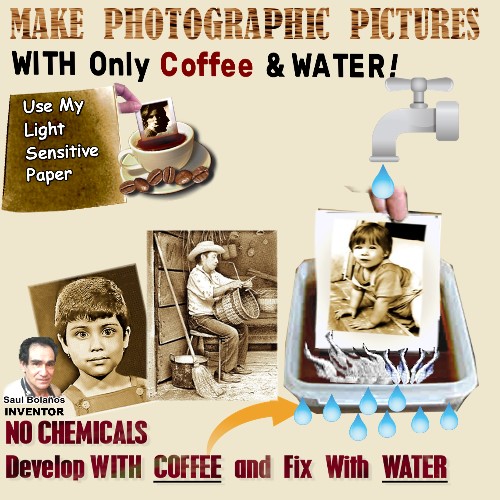 Coffee Art that the world had never seen before was exhibited there until about the 2000. Coffee Developed silver images are not offered to the public today on a any scale.
Coffee Art that the world had never seen before was exhibited there until about the 2000. Coffee Developed silver images are not offered to the public today on a any scale.
The newly found coffeetype process (the improved ozotype above) made a big fortune for me and the large funds gave me freedom and independence to direct my research to the direction I wanted.
This Success was an inspiration for me to develop many more original coffee art procesess based in different principles. I Also engineered a silver chloride emulsion which
can be developed with coffee and BE FIXED WITH PLAIN WATER ! This is the most ecological silver process ever devised in the history of photography.
BELOW ARE THE FORMULAS
USED I N THE YEAR 2015.
(for formulas of the year 2021,
And how to make a "TRANSFER PAPER"
with silver chloride emulsions is in My book: "MAKE PICTURES WITH COFFEE
"how to develop pictures with coffee
this page will tell you how to develop silver based photographic paper with coffee solutions:
1. DEVELOPER: how to make the ground coffee solution
2. HOW TO EXPOSE AND PROCESS THE COFFEE PRINT
shown below: how to work liquid light sensitive photographic emulsions for positive work. any high quality, exposed, silver based photographic emulsion can be reduced with coffee. the same applies for negative work, glass plates or film coated with photographic emulsion can be developed with alkaline coffee solutions. instructions here apply to my SILVER CHLORIDE EMULSION number 4. formulas has already been given in this book IN SEE CHAPTER 8. this process is non toxic. requires no darkroom or machines.
THIS PAPER IS MULTI-TONE.
if you like sepias from red to brown include kitchen salt in the coffee solution weighting must be exact, salt in excess will prolong developing time longer than the times given here. all other thing being equal exposure time has great influence in the developed tone or color. generous overexposure gives red chocolate tones, short exposures tend toward colder sepias. by varying exposure time under the same negative and reducing or prolonging developing time, any tone from warm black to cherry RED can be obtained. More effective than kitchen salt for this purpose is adding potassium bromide to the mixed developer.
during the progress of development the print undergoes tone changing, first it is pale orange then it turn to cherry red, later to coffee browns and as developing progresses it may turn to warm sepia black, this is the result of "developing to finality" which mean colder more contrasty sepias, but the print may be pulled out rapidly out of the solution if desired when it is still in the warm tone stages of development, and to arrest further activity rapidly, to retain the color, immersed then immediately in cold water..
CAPACITY OF MIXED DEVELOPER
for repeatable results use the activated coffee only once. it may be used twice but within an hour or two after mixing it or activating it with the ACTIVATOR, if a portion of activated coffee has been used only once and it is stored taking all the air out of the vessel, it can be used again during the next 12 hours if mixed with equal parts of freshly mixed activated coffee developer, developing time may have to be prolonged a little and it will give even warmer and more even tones particularly in the middle lights, a too long developing time may
degrade the whites with a stronger coffee stain, so it is better to give the photographic paper plenty of light exposure time under the digital negative to keep developing time to a minimum. unused activated coffee developer keeps in good active condition for about 4 hours if stored completely airless.
HOW MUCH COFFEE TO USE
use the minimum, for economy mix enough to cover the paper comfortably during continuous agitation and use a tray that is just a little larger than the paper to be developed. The more coffee developer you use per area of photographic paper to be develop, the more density the final silver print will have. THE MIXED DEVELOPER WILL NOT ATTACK YOUR SKIN.
HOW TO WORK SAFELY UNDER ROOM LIGHTS WITH MY SILVER CHLORIDE
PHOTOGRAPHIC EMULSION NUMBER 4 CHAPTER 8
working at 4-6 feet from a incandescent light bulb of 25 - 50w strength is safe. test yourself your conditions in this way: cut a piece of the lucenta photographic paper and cover half of it with cardboard in a manner that only half of it receives the light. place it at the distance where you are going to be developing the paper. expose to the light during 10 minutes. develop the strip with coffee. note if the whites are pure and clear of fog. if not, reduce wattage of bulb, work further from the light source or shade the paper during development which is effected with moderate but continuous agitation as shown below.
HOW TO EXPOSE AND PROCESS THE COFFEE PRINT
exposure times given are for first trials, correct exposure will depend on density of the negative IMPORTANT : the glossy side of the paper is the "emulsion side" which should be placed in contact with the negative.

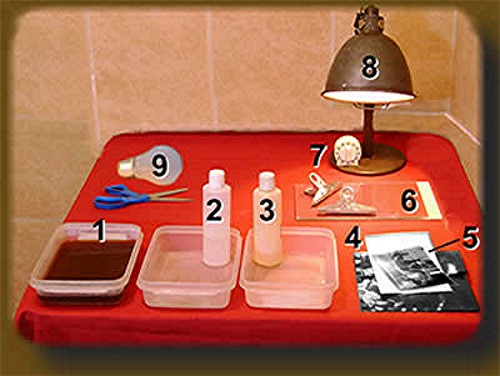
REFER to picture above: 1. coffee 2. natural alkali to neutralize coffee acidity 3. optional: drinking alcohol for quick drying 4. paper coated with silver chloride emulsion 5. Black and white digital negative you can make this in the computer( see chapter 13) 6. two glass plates to press neg and photo paper together for exposure 7. minute timer 8 and 9. 100w ordinary incandescent lamp.
DEVELOPER
how to make the ground coffee solution
do not use instant coffee, it may give poor contrast and for same reason do not add any alcohol to preserve it or DO NOT use coffee that has sugar in it.
Dissolve 25 grams of roasted ground coffee in 250 ml of boiling water. (or 1 part coffee by volume with 3 volumes of water) Keep boiling for 30 seconds, take out of fire let sit and decant the liquid off the top for use or strain it to separate the coarse grounds(discard these) and then filter the liquid through cloth or filter paper.
STORAGE: will keep in good condition for use for 12 days. Final volume of the coffee, after separating the grounds, should be around 150 ml (concentration 14 -16% coffee)
stale coffee solutions will develop too slowly, require more light exposure and yield poor contrast, for this reason Keep the liquid coffee under refrigeration taking all the air out of the bottle. Air will oxidize the developing agent present in coffee very quickly.
ACTIVATOR:
prepare the alkali: sodium carbonate
the acid in coffee requires to be neutralized in order to develop within a short time. of the many possible alkalis to activate the coffee solution, sodium carbonate is to be preferred because it is mild and it is EASY available. prepare a saturated solution (about 9-12 grams in 100 ml of hot water) of anhydrous Sodium Carbonate (also known as soda ash) it keeps indefinitely.
how to make the Coffee developer
15% ground coffee solution (as above) ...1 Party by volume
ACTIVATOR.......................................................1 part
HOW TO EXPOSE AND PROCESS THE COFFEE PRINT
exposure times given are for first trials, correct exposure will depend on density of the negative IMPORTANT: the glossy side of YOUR COATED paper is the "emulsion side" which should be placed in contact with the negative.

1. press negative in contact with photo paper 2. expose to light for 5-20 seconds 3. separate negative from the exposed Paper.
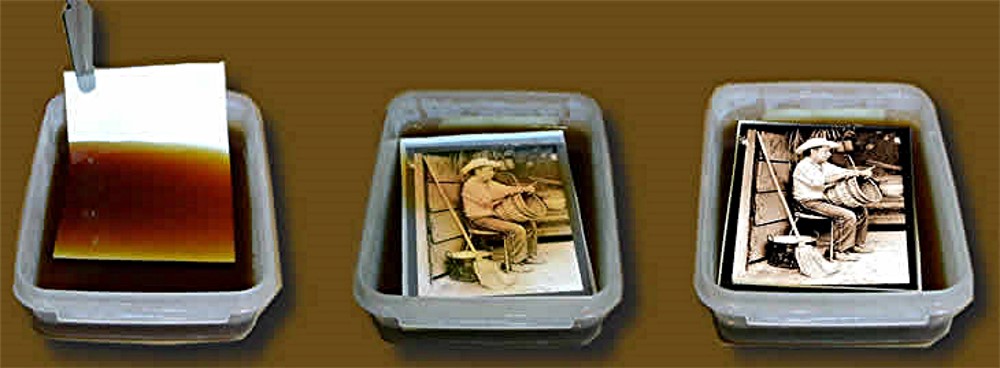
4. immerse exposed paper in coffee 4. faint image begins to appear soon 4. final stages of developing 2-4 minutes.
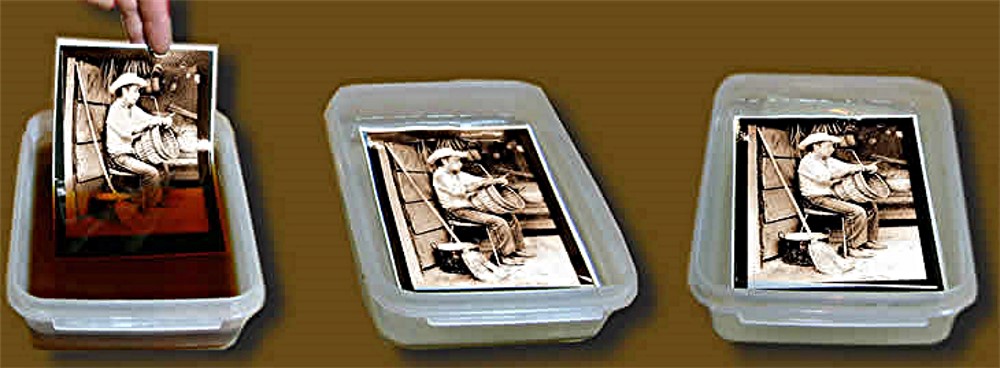 4. end of developing with coffee 5. rinse paper in cold acid water 6. fix in plain thiosulphate.
4. end of developing with coffee 5. rinse paper in cold acid water 6. fix in plain thiosulphate.
 7. HOW TO WASH
7. HOW TO WASH
THE COFFEE ART WORK
The thiosulphate employed as a fixer if left in great quantities in the paper fibers will turn the picture yellow in a few months and it will make it completely fade over time.
a well fixed and washed picture on pure fiber paper will last over 100 years ! this if the fixing bath is fresh and the paper washed gently under water for 20 minutes, alternatively a better plan is to immerse the paper under water in a tray and washing done with still water, changing the water every 5 minutes. 6 changes of fresh water each lasting for 5 minutes for a total of 30 minutes will do.
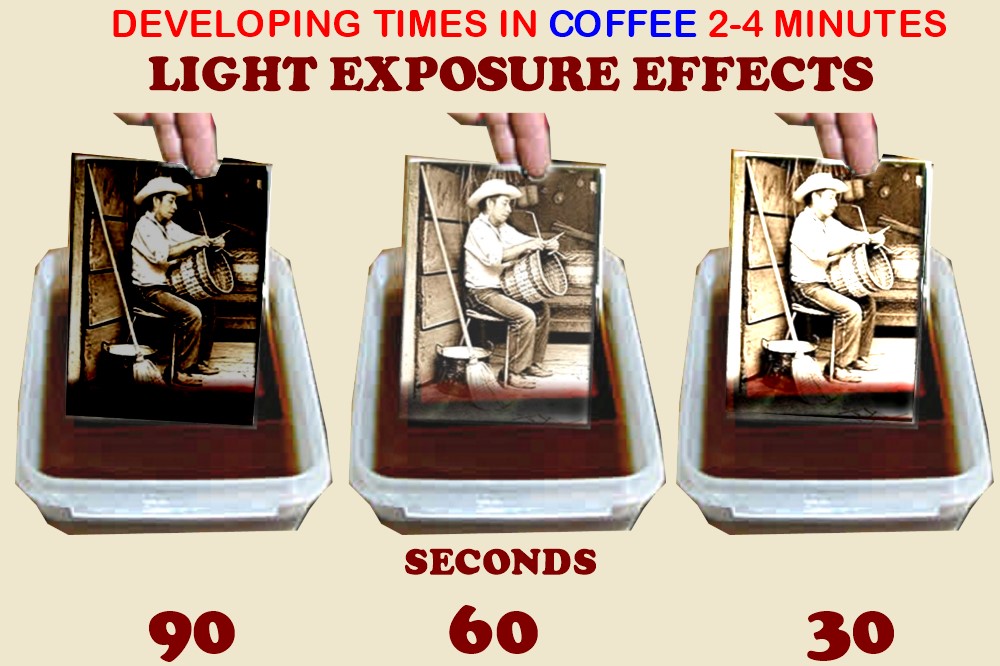
90 seconds:OVER-EXPOSED. 10 seconds CORRECTLY EXPOSED.
30 seconds: UNDER-EXPOSED
all samples shown exposed at 50-100 cm distance under an ordinary incandescent 100w bulb and developed with coffee activated with sodium carbonate during 4 minutes/ at 20c. the digital negative was made in a computer program and printed with black inkjet ink on clear acetate; was exposed by contact on silver chloride paper. note that:
EXCESSIVE OVER-EXPOSURE: of 90 seconds yields a picture too dark. (with a thin negative) the whites of the picture instead of being white are grayish lowering contrast.
EXCESSIVE SUB-EXPOSURE: of 30 seconds results with an image with pure whites but without much middle tones and stronger staining of the whites by the color of the coffee.All exposure times given here are relative. the actual exposure time may vary depending how rapid you made the emulsion.
CORRECT EXPOSURE: of 60seconds , shows cleaner whites, strong tones with details in the highlights. developing time may be shortened or prolonged to compensate for exposure errors, but maximum quality with minimum staining of the whites can best be attained by adjusting exposure to develop in no less than 2 minutes and no more than 4. with a 200w bulb instead of 100w, without changing distance from negative to bulb exposures times can be reduced greatly, after a few trials excellent pictures will be created.
DEVELOPING TEMPERATURE IS IMPORTANT, THE COLDER THE COFFEE SOLUTION THE SLOWER THE DEVELOPING RATE. at colder temperatures THE CONTRAST IS HIGHER AND THE WHITES ARE CLEANER. recommended temperature is 15 - 20c,
---------------------------------------------------------------------------------------------
SEE CHAPTER 11 FOR FORMULAS OF STOP AND FIXING BATHS
---------------------------------------------------------------------------------------------
CONTACT

COSTA RICA © 2025, saul bolaños
CAFEDESAUL@GMAIL.COM